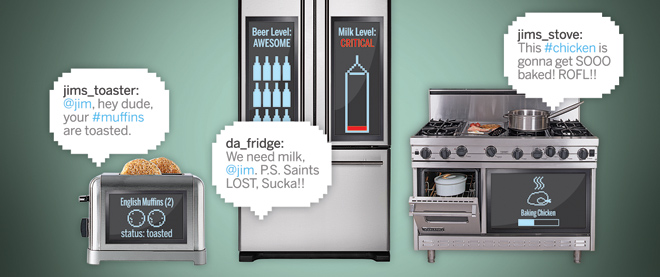The kitchen at the end of the universe
Can’t wait to watch ‘Glee’ on a high-tech $1,000 blender? No? You will soon anyway.
Share
 Good news, everyone: the age of the “connected home” is nearly upon us! Soon we’ll be able to spend thousands of dollars on an Internet-linked washing machine, a Wi-Fi-enabled oven and maybe a sentient, wisecracking toaster of some kind. Think of the benefits of making our household contraptions more advanced and connected: I for one can’t wait to go online and read the Facebook status updates of celebrity-owned appliances (“Kirstie Alley’s refrigerator . . . is being ravaged”).
Good news, everyone: the age of the “connected home” is nearly upon us! Soon we’ll be able to spend thousands of dollars on an Internet-linked washing machine, a Wi-Fi-enabled oven and maybe a sentient, wisecracking toaster of some kind. Think of the benefits of making our household contraptions more advanced and connected: I for one can’t wait to go online and read the Facebook status updates of celebrity-owned appliances (“Kirstie Alley’s refrigerator . . . is being ravaged”).
No longer shall humans be forced to open the fridge door to see if there’s milk left. This taxing ordeal will be replaced by the simplicity of logging the milk’s arrival on a touchscreen keypad, typing in its expiry date, routinely taking note of its level, providing our mobile phone number and reading a text message sent by the fridge indicating it’s time to buy more milk. What could be easier?
The dawn of connected appliances has been predicted, touted and hyped for years now. Perhaps some figured that appliance manufacturers had given up on the idea—but no. GE, Sub-Zero and others have never wavered in their quest to answer the vexing question that has long plagued us as a species: why can’t I use my dishwasher to tweet?
These new gizmos are a marvel to behold. Take Samsung’s Internet-enabled refrigerator, which is expected to go on sale this spring for about $3,500. It features a video interface that runs apps, displays news stories, creates to-do lists and enables family members to post to Twitter. If Samsung engineers can somehow find room for a compressor, the fridge may even keep stuff cold. Amazing.
LG, meanwhile, is introducing an oven that can access a computer server, download preprogrammed recipes and display them on a built-in screen. And thank heavens for that, because until now there has been no way to obtain recipes other than by computer, iPad, smartphone, book, magazine, cereal box, soup can, memory, guesstimation or grandmother. And who’s ever got any of those handy?
LG’s new refrigerators go even further. They allow you to use a “drag-and-drop” menu to keep track of precisely where each food item has been placed inside. This will be a godsend to all of us who store our butter at the middle of the minotaur’s labyrinth. And that’s not all. An excited LG spokesman noted in a recent news story: “I have the ability to see what’s in my fridge from my phone!” What a perfect tonic for those of us who get separation anxiety from our ham.
The visionaries behind connected appliances are building their industry on the indisputable theory that if you take one good idea (household appliances) and combine it with another good idea (wireless Internet), you can’t help but wind up with an idea that is, at minimum, double good.
Sure, maybe we ordinary folk have trouble seeing the merits of one day watching an episode of Glee on a $1,000 blender. But that’s our fault. As a recent news story put it: “It can be hard to explain to consumers all the promise of a Web-connected dishwasher or washing machine, but [an executive at Whirlpool] said they’re inevitable.” Got that? Inevitable. So stop not understanding why they’re building it and start not understanding why you’re buying it.
Those who question the viability of connected appliances just don’t grasp how business works. It’s about the relationship between supply and demand. When there is absolutely no demand, you need to compensate with an overabundance of supply. At least that’s how Hollywood did it a few years back with Jude Law movies.
It comes down to this 21st-century maxim: if something can be made with technology, it must be made—whether we want it or not. That’s how we ended up with the Segway, Cher’s face and Dubai.
As one industry executive put it: “We’re connecting devices that have never been connected before and we’re connecting them to you.” Why? Who knows. To what end? Who cares. The only certainty is that we won’t stop there. Next we’re going to connect your toothbrush to your car engine. Then we’re going to connect your razor to your vacuum. It won’t make your life any easier, but the devices will enjoy being able to talk about you behind your back.